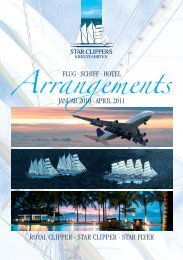TANZANIA PDF 2007
TANZANIA PDF 2007
TANZANIA PDF 2007
You also want an ePaper? Increase the reach of your titles
YUMPU automatically turns print PDFs into web optimized ePapers that Google loves.
M ost<br />
The Southern Circuit<br />
visitors to Tanzania will<br />
fly in via Dar es Salaam,<br />
which means “Haven of<br />
Peace”, reflecting the relaxed and<br />
informal atmosphere of the city.<br />
From here visitors can take a fly-in<br />
safari to the game reserves to the<br />
south.<br />
Less frequented than the national<br />
parks in the north, the southern<br />
parks provide a sense of African<br />
adventure unsurpassed anywhere on<br />
the continent.<br />
The principal areas are Selous<br />
Game Reserve and Mikumi, Ruaha<br />
and the Udzungwa Mountains<br />
National Parks.<br />
MIKUMI NATIONAL<br />
PARK<br />
Located north of the Selous Reserve,<br />
less than 300 km. from Dar es<br />
Salaam, is the Mikumi National<br />
Park. Because of its accessibility it is<br />
one of the most popular parks in<br />
Tanzania and is an important centre<br />
for education where students go to<br />
study ecology and conservation. A<br />
wide range of wildlife inhabits its<br />
3,230 sq km area.<br />
The Mikumi flood plain, with its<br />
open grasslands, dominates the park<br />
together with the mountain ranges<br />
that border the park on two sides.<br />
Lion is commonly seen as are packs<br />
of wild dog, rare elsewhere in<br />
Africa. Elephant may be<br />
encountered and other animals<br />
frequently observed are buffalo,<br />
civet, eland, giraffe, impala, kudu,<br />
reedbuck, warthog, waterbuck,<br />
wildebeest, zebra and Lichtenstein’s<br />
hartebeest. Near the southern<br />
boundary of the park it is possible to<br />
see groups of female and young<br />
bachelor sable with their one<br />
dominant male.<br />
Crocodiles, monitor lizard and<br />
python are other residents.<br />
At the southern end of the flood<br />
plain, in the Kikoboga area, families<br />
of yellow baboon live while<br />
wallowing hippos are frequently<br />
joined in their pools by flocks of<br />
open-billed storks, hunting for<br />
molluscs.<br />
Over 400 species of birds have<br />
been observed in the park, many of<br />
which are Eurasian migrants who<br />
stay between October and April.<br />
Getting there: A four hour<br />
drive, or a one hour flight,<br />
from Dar es Salaam. ���<br />
17 CONTENTS







